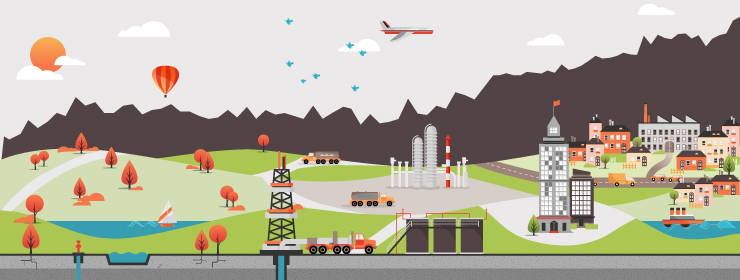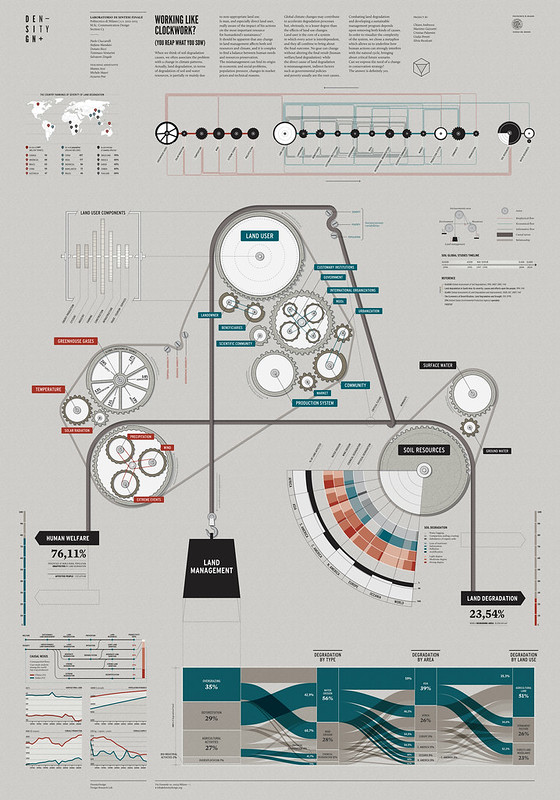Poster: Working Like Clockwork? (you reap what you sow)
When we think of soil degradation causes, we often associate the problem with a change in climate patterns. Actually, land degradation, in terms of degradation of soil and water resources, is partially or mainly due to non-appropriate land use.
Is man, and especially direct land user, really aware of the impact of his actions on the most important resource for humankind’s sustenance?
It should be apparent that any change in land management affects both soil resources and climate, and it is complex to find a balance between human needs and resources preservation. The mismanagement can find its origin in economic and social problems, population pressure, changes in market prices and technical reasons. Global climate changes may contribute to accelerate degradation processes but to a lesser degree than the effects of land use changes.
Land user is the core of a system in which every actor is interdependent, and they all combine to bring about the final outcome. No gear can change without altering the final result (human welfare/land degradation): while the direct cause of land degradation is mismanagement, indirect factors such as governmental policies and poverty usually are the root causes. Combating land degradation and developing a sustainable management program depends upon removing both kinds of causes.
In order to visualize the complexity of the system, we chose a metaphor which allows us to underline how human actions can strongly interfere with the natural cycle, bringing about critical future scenario.
Can we express the need of a change in conservation strategy? The answer is definitely yes.
Report: What the Frack is Going on?
Hydraulic fracturing is a technical term indicating the human-induced creation of fractures in a rock layer through the injection of a highly pressurized fluid in order to release petroleum, natural gas and other substances for extraction. For United States in particular, but also for other countries whose need of hydrocarbons is constantly rising and aims for a national independence, natural gas obtainment from shale gas extraction could exploit previously unproductive reserves and, in so doing, reduce the purchase and consumption of other ‘less green’ fossil fuels, with a consequent reduction in greenhouse gases emissions. On the other hand, the hydraulic fracturing cycle involves the employment of large amounts of water and requires a controlled disposal of the flowback fluids, in order to avoid risks of ground and surface water resources contamination.
Our report investigates the debate following a Digital Methods approach to answer the research question: “With the hydraulic fracturing practice and related public attention raising all over the world, which are the priorities in fuel extraction, considering economic actors, scientific community, policy makers and stakeholders?”. Find out more on the dedicated website.
App: What the Frack?
What the Frack is an application which allows the user to approach the complexity of the fracking controversy. The app is designed to introduce the user in the controversy by giving information and showing different opinions. The aim of the application is to provide a guide which could help the user in the understanding and decision-making regarding the debate. After a cover and a short introduction focusing on the explanation of the practice, the user enters the fracking city and is soon asked to make a choice according to his/her priorities. The user’s choice will affect the future of the city: indeed, we developed three different scenarios, based on different priorities in fuel extraction, such as environment, energy and community. After choosing the scenario the user is allowed to explore the respective city, with its benefits and disadvantages: the illustrations set and the datasets are different for every scenario. The user can dig into them finding out all the information about the controversy around hydraulic fracturing. The app offers two kinds of interaction: you can browse the three scenarios in a straightforward and playful way, but you can also go in depth, exploring an informative background layer. The aim was to involve the user in the experience, through a “learning by interacting” perspective, where the features of the device offer a way to captivate the attention. After implementing the app, our team designed a promotional video that suggests the app as an orientation tool in the fracking controversy.
Have a look at the app promo!
References
FAOSTAT
EPA,United States Environmental Protection Agency
BP – Statistical review of world energy 2012
Authors
Chiara Andreossi
Massimo Guizzetti
Cristina Palamini
Giulia Peretti
Silvia Recalcati




